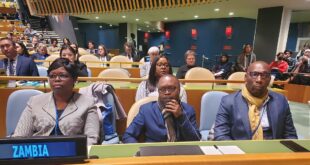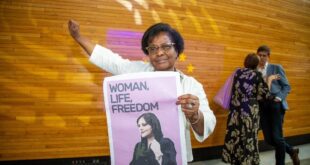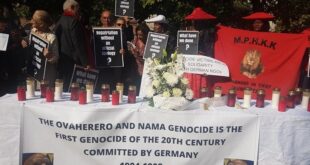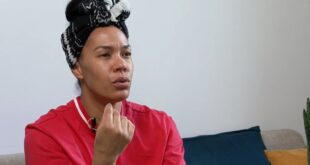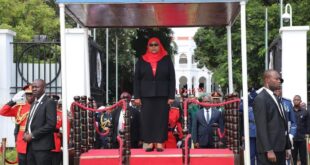The wood-frame house that was once home to the civil rights pioneer Rosa Parks has been sitting as an art exhibit in a garden in the Wedding neighbourhood of Berlin since 2016. The symbol of the American civil rights era has attracted many visitors including Germany’s Vice-Chancellor Sigmar Gabriel. Clementine Ewokolo Burnley writes on the relevance of the house to the struggle of Black people today.
——————————
Rosa Parks’ house is in Berlin. Her niece, Rhea, bought it for 500 dollars but couldn’t stop Detroit town planners when it was due to be demolished. Rhea McCauley didn’t know what to do. She asked Berlin-based artists, Ryan and Fabia Mendoza, for help. Now the house of a civil rights icon nestles beside the home of a Berlin-based American artist, safe from demolition. No one in Detroit was willing or able to save the house, and then, help arrived from Germany. The German garden in Wedding, Berlin, not so far from the Afrikanisches Viertel. But how did Rosa’s house come to leave her home, neighbours and community Montgomery, Alabama, for Detroit? And what happened to the bus?

Historical continuities
The red thread for this piece is, historical continuities between the black American civil rights struggle of the 1950’s and the struggle against forms of violence black people face today,— urban gentrification, racial profiling, migration and deportation policy.
Rosa Parks’ two-story clapboard house also reminds me of the colonial town in Cameroon, where I grew up. I find that a nice way to begin to connect this civil rights icon to my own experiences. Cameroon was colonized by Germany, France and Britain. Until today in Cameroon, because of colonial racist ideas, White and Black people live very separate lives. That’s why Rosa Parks’s actions are relevant to my present day life. There are continuities between her context and mine.
Germany is painfully redefining itself as a migration society. At the same time politicians and the mainstream press have used familiar ideas, – of White women being in particular danger from Black and Brown men. Rosa Parks would recognize these widely shared ideas, which have sexualized, racialised and criminalized non-White people, making their lives even more dangerous.
Connecting Afrikanisches Viertel to Detroit
What are the other threads that link the Afrikanisches Viertel in Wedding, to Detroit? Wedding is a centre for working class life and African migrant life in Berlin. The rents there used to be low. Rents are rising, poorer people are leaving. Where Rosa Parks lived in Detroit was also a centre for Black life called Black Bottom. Black Bottom was redeveloped and now, richer people live there. The Black artistic community has left to live in cheaper places.
I wondered why the city of Detroit didn’t keep the home of a civil rights icon, instead leaving it to be rescued by the Mendozas. The narrative the international media have chosen for the Rosa Parks house is one that compares heritage culture in Germany and the United States.
German “Errinerungskultur”, literally translated, “Memory culture” is how a post-fascist state deals with its past, by erecting and preserving monuments to important, anti-fascist figures and moments. While local people in Wedding were interested, they didn’t know much about Rosa Parks. On the Facebook page of the Rosa Parks House, a lone comment points out that most of the discussion is taking place in English.
“Wer Keen englisch kann Is bei euch echt im arsch Ihr Mäuse und Frieden”
It’s important to notice when people feel excluded from public debate. Silencing and exclusion happens frequently to members of migrant communities. Black German communities are almost invisible in Germany. Yet they have a lively civil rights struggle too.
Separate realities
Before I began to research this piece I thought of Parks as a tired lady who refused to move to the back of the bus and accidentally ignited a movement to end segregation on public transport in the United States. After Parks was arrested, Black people boycotted public transport in Montgomery, Alabama for 382 days.
Actually Rosa Parks planned the strategy together with the other leaders of the civil rights movement (the NAACP – National Organisation for the Advancement of Colored People). She waited for something very “normal” in the everyday life of a black person in 1955. She was sitting in the “Negro section” on the bus when the bus driver noticed that the White section of the bus was full and White passengers were standing. He asked six Black passengers give up their seats. When Rosa refused, he called the police. This is a completely recognizable moment. The police continue in many cases to make sure White people get the world, which is safe and separate from non-White realities.
In the 1950’s it was the same throughout the world. In the colonies, of Africa and Asia, White and non-White people lived, went to school, played sports and worked separately. The police were there to make sure that all around the world, White people were kept separate, as safe as could be ensured from non-White realities: violence and poverty.

Thread of continuity
Remember the thread of continuity? Nowadays segregation is unofficial. Segregation is instead created through immigration policies that bar most older people, non-White people and poor people from wealthy countries. Internal security policies inside wealthy countries racialise, criminalise and pre-emptively police Black and Brown people, Muslim people and people read as non-White migrants. Racial profiling, racist migration policy, brutal deportations of non-Whites from wealthy countries are necessary and desired tools of global racial segregation.
If you stay on the bus in 1955, in that iconic moment, it’s easy to Miss Rosa Parks’ migration from Montgomery, Alabama in the narrative about her house being moved from Detroit to Berlin. Rosa Parks faced threats that meant she had to go and live with her brother and his family in Detroit. The bus stayed in Alabama. The world moved on and now, in many people’s eyes the necessity for civil rights, for resistance to the violence Black people face today, is sometimes questioned.
Saying ‘No’ today
If Rosa Parks’ refusing to get up from her seat in the bus in Alabama is a ‘No’ to the 1950’s variety of White supremacy, what are the ‘No’s’ we say to the forms of supremacy Black people in Europe faced in the past and continue to face today? Thirty years ago Jasmin Eding, Ria Chiatom, Katherina Oguntoye, and the other co-founders of ADEFRA (Schwarze Frauen in Deutschland) said ‘No’ to racism and social isolation of Black women in Germany. The ISD (Initiative Schwarze Menschen in Deutschland) says ‘No’ to racial profiling in Germany today. The Oury Jalloh Initiative says ‘No’ to violent policing and deadly miscarriages of justice that affect migrants today.
Of course Rosa Parks was not the first person to refuse to give up her seat to a white person. Before Parks, among others there was fifteen year old Claudette Colvin. Two White policemen carried the teenager off a bus in Montgomery, to free her seat for a White woman. While taking her to an adult prison the police used the familiar sexual and racial insults that Black children face today. The officers at the prison called her “thing” and “whore”.

Colvin was young, working class, dark skinned and quickly became an unmarried mother. She didn’t make as good a candidate for the leaders of the civil rights movement, as Parks, who was older, married, politically savvy and a teacher. Young people, visible migrants, non-Europeans, refugees, women, single mothers, working class people and the poor, continue to face violence and are often marginalized from public attention to their situations, from control of funding and from leadership of political organisations. That needs to change.
—————————-
Clementine Ewokolo Burnley is an African-European writer, 24 hours a day mother and community worker. She writes about loss, survival, decolonialism and cultural hybridity, mostly recently in Witnessed series, Versal Journal, The Feminist Wire, Parabola Magazine, The Bristol Prize 2017 Anthology. You can find her blogging on ezibota.org or on Twitter at @decolonialheart
 THE AFRICAN COURIER. Reporting Africa and its Diaspora! The African Courier is an international magazine published in Germany to report on Africa and the Diaspora African experience. The first issue of the bimonthly magazine appeared on the newsstands on 15 February 1998. The African Courier is a communication forum for European-African political, economic and cultural exchanges, and a voice for Africa in Europe.
THE AFRICAN COURIER. Reporting Africa and its Diaspora! The African Courier is an international magazine published in Germany to report on Africa and the Diaspora African experience. The first issue of the bimonthly magazine appeared on the newsstands on 15 February 1998. The African Courier is a communication forum for European-African political, economic and cultural exchanges, and a voice for Africa in Europe.






